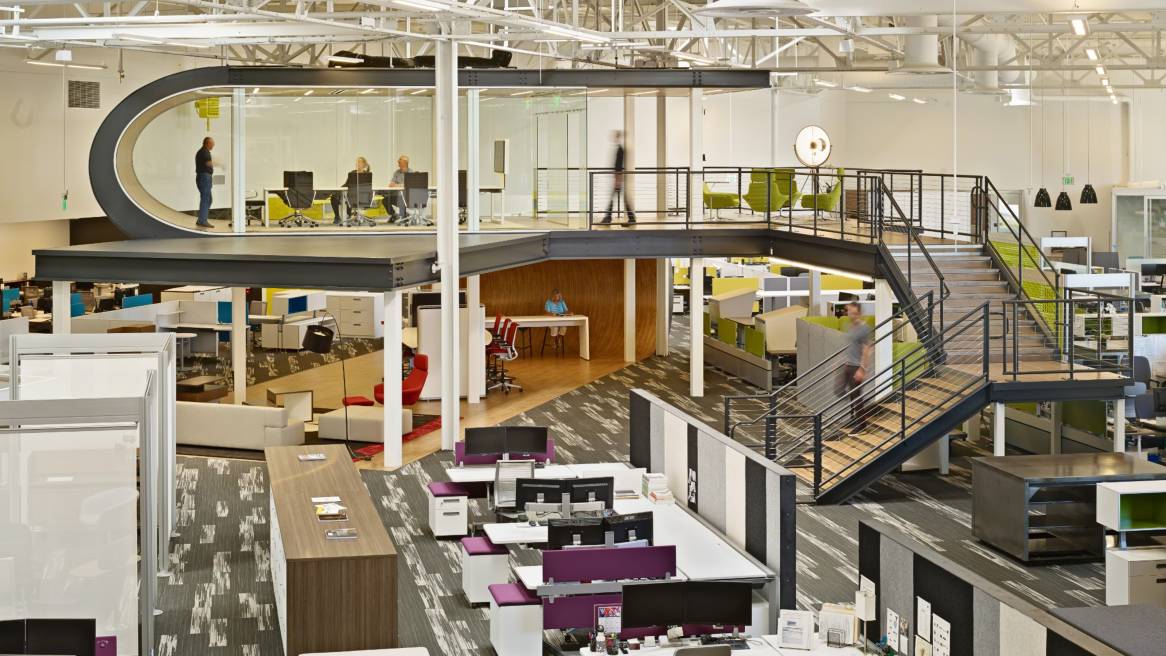Insights and Data Transform Workplace Culture
How One Workplace leveraged data and insights to better support its growing team.
One Workplace, Santa Clara, CA
One Workplace has a long history of designing great workspaces for some of the world’s most innovative companies. In fact, to call the One Workplace headquarters in Santa Clara an “office” doesn’t quite fit the fully-functioning, 3,500 square metres showroom that the company doesn’t just showcase—but uses. The headquarters aligns with the company’s mission: To create space that inspires people and transforms organisations. For One Workplace, people, place, and technology should all work together seamlessly to reinforce culture as well as productivity.
Recently One Workplace found itself struggling with some of the same issues it solves for its clients. After adding more than 25 percent to its workforce, their current environment started to feel cramped. The shine had rubbed off, and the office just didn’t seem to fit like it used to.
To find out how team members were using the space, and what an expansion would look like, One Workplace enlisted Workplace Advisor – Study for a deeper insight.
Workplace Advisor – Study is a space measurement tool from Steelcase. It deploys sensors and other evaluation tools in a one-time episodic use when an organisation is looking to justify a large capital expenditure and improve the overall employee experience. One Workplace needed data to determine if they were really using space the way they thought they were. But Workplace Advisor – Study doesn’t just provide objective occupancy data. It also collects qualitative information, letting employees weigh in on their favorite workspaces and space traits through surveys to better understand why some spaces are used and others are not.
“Data is important. But it only matters if we can use it to help our employees and customers have a better day at work,” said One Workplace Chief Operating Officer, Mark Baker. “The space is culturally valuable. The sensors alone wouldn’t tell us that. But, when the data was paired with honest qualitative feedback, we gathered a more complete picture of how we can best support our team.”
“…when the data was paired with honest qualitative feedback, we gathered a more complete picture of how we can best support our team.”
When Steelcase analysed the Workplace Advisor – Study data, the results were surprising. Despite having 260 people in the Santa Clara headquarters, the team on average was only using 36 percent of its space. And the qualitative data explained why. Even though 3,500 square metres was more than ample, the design wasn’t supporting the type of work people were doing, or the One Workplace culture driving that work.
“It wasn’t that we didn’t have enough space. We didn’t have the right kinds of spaces.”
“It wasn’t that we didn’t have enough space. We didn’t have the right kinds of spaces,” said Creative Director, Chris Good. “Private space and meeting space are not the same thing. We recognise how space can help shape behaviour. We want to use our company culture to drive behaviours and design space around it.”
For example, Workplace Advisor – Study reported One Workplace had 20 one or two- person sessions occurring in private settings at any given time, but only nine spaces designed for those interactions. This might be people taking phone calls, doing heads down focus work or working with another colleague to review a project.
One Workplace also discovered that team members were choosing conference rooms over their own desks for individual work. There was also a strong internal movement to work remotely outside the office. Ultimately team members felt like the environment didn’t do a terrific job supporting the different ways they wanted to work. And One Workplace wasn’t utilising technology to help team members reserve the spaces they were actually using.
“You can design solutions to create change, but only if you are also working to help people embrace that change. In the end, what we’re solving for isn’t about numbers, it’s human experiences,” said Good.
For One Workplace, what started as an inward look into their own environment has turned into a hands-on exercise that’s helping them create a space that showcases what’s possible when data and culture come together. It’s also helped reinforce their core belief: that company culture shouldn’t be left to define itself. Designing around behaviours and culture will ultimately lead to a better, more productive workday.
“It’s not just our work environments that are changing incredibly fast,” said Good. “How we work within those environments is changing just as fast. And even though we design workspaces for a living, we’re susceptible to the same forces our clients are. This was an incredible opportunity for us to take a closer look at how we design around culture and behaviour.”
One Workplace will begin implementing these changes over the coming year. 360° will share their new space when it’s completed.


